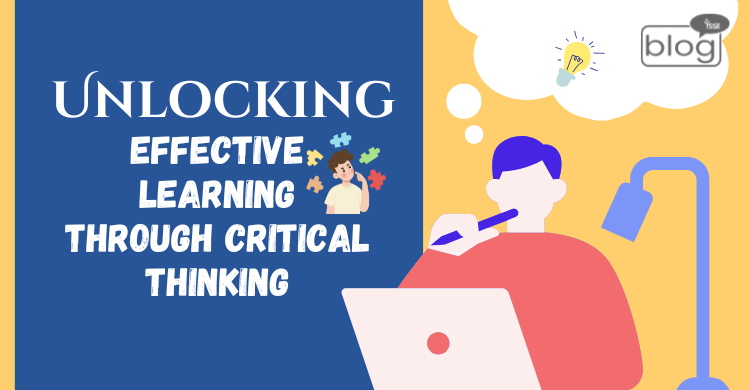In a knowledge-filled world with a lack of wisdom, critical thinking has never been more relevant. While traditional learning is prone to memorization and cookie-cutter approaches, real learning takes place when learners begin questioning, analyzing, reflecting, and judging. This is where critical thinking is the passport to successful learning – a revolutionary skill that not only allows one to learn knowledge but also apply it constructively in real-world applications.
What is Critical Thinking?
Critical thinking is literally the ability for logical and reasonable thinking about information. It involves fact analysis, distinguishing between assumptions and facts, detecting prejudice, and forming sound judgments. Compared to passive learning, which will be superficial, critical thinking goes deeper, challenging the here and now, and educating learners to be inquisitive, questioning, and self-directed.
Why Learning Alone Is Not Enough
Let’s be real- anyone can Google a fact or photostat the pages of a textbook. Memorizing, though, is different from truly understanding. Critical thinking bridges this gap because it enables students to absorb facts, question if they are valid, and apply them in novel ways.
Without critical thinking:
- Students may pass exams but have no idea how to solve real-life problems.
- Experts must follow instructions but not to think.
- Individuals are misled by fake information even without being aware.
How Critical Thinking Exposes Deeper Learning
The following is the way critical thinking redefines learning:
- Promotes Active Participation
Asking the “why” of what is being learned turns the students into active learners and not passive recipients. They begin connecting on their own with the learning, which results in greater retention and curiosity.
Example: Instead of memorizing dates of history, students can ponder the whys and what ifs of events and relate them to the society of today.
- Fosters Open-Mindedness and Flexibility
Critical thinkers embrace fresh ideas. They recognize that knowledge is not stagnant but is a state of continuous flux and truth can be plural. This type of thinking facilitates flexibility- an incredibly desirable virtue in today’s fast-changing world.
Open-minded students will flourish in multicultural, globalized worlds where varied perspectives are not just tolerated but cultivated.
- Sharpened Problem-Solving Skills
Critical thinking allows for breaking down complex problems into bite-sized pieces. Students become able to balance evidence, evaluate risks, and make sound decisions. This is particularly useful in STEM, medicine, law, and business, where sound logic is essential.
In the future with AI, human-judgment-based problem-solving will be a rare skill that machines will not be able to duplicate.
- Creates Confidence and Independence
When students finally ask and question course work, they feel more at ease in their own minds. They’re less beholden to other individuals for the answers and more likely to go out on the limb and do some new exploring, so it’s an independent process.
Critical thinkers become life-long learners who are motivated by curiosity, not obligation.
- Limits Vulnerability to Misinformation
In a time of misinformation, disseminated like brushfire in the age of the internet, critical thinking is a firewall of the mind. It teaches students to verify sources, recognize fallacies, and be wary of sensationalized truths- essential traits for intelligent citizenship.
This positions education not just as individual property but as a group shield against propaganda and manipulation.
How to Encourage Critical Thinking in Learning Spaces
Enabling critical thinking to successful learning is not second nature – it must be done with deliberate tactics. Here are some ways educators, parents, and students themselves can do that:
a) Socratic Questioning
Use open questions like these to stimulate discussion:
- “What evidence supports this assumption?”
- “Are there different perspectives?”
- “What if…?”
This promotes depth of thought and allows the students to learn to think, not what to think.
b) Project-Based Learning
Problem-solving and real-life situations allow the students to apply theoretical concepts to an actual environment. It promotes critical thinking, collaboration, and creativity.
c) Debate and Dialogue
Foster healthy debate in which disagreements are not only acceptable but desirable. It allows learners to view various aspects to a problem, stimulating empathy and discrimination.
d) Reflective Journaling
Writing down one’s own individual thoughts of what one has discovered has the effect of fixing learning and acquiring the habit of reflection- an important part of critical thinking.
Final Thoughts
Critical thinking is not a talent- it’s a disposition. It transforms students from readers of books to writers of books, and makes them able to learn beyond books, challenge assumptions, and create a wiser world.
In a world where we are bombarded day after day with information, critical thinking not only enhances learning- it emancipates it.
Regardless of whether you’re a student, educator, parent, or just an avid learner, applying this type of thinking guarantees that you’re not merely studying to pass an exam- you’re studying to think, to develop, and to lead.
To read more blogs like this, click here
Writer,
Nafisa Tasnim
Intern, Content Writing Department
YSSE

